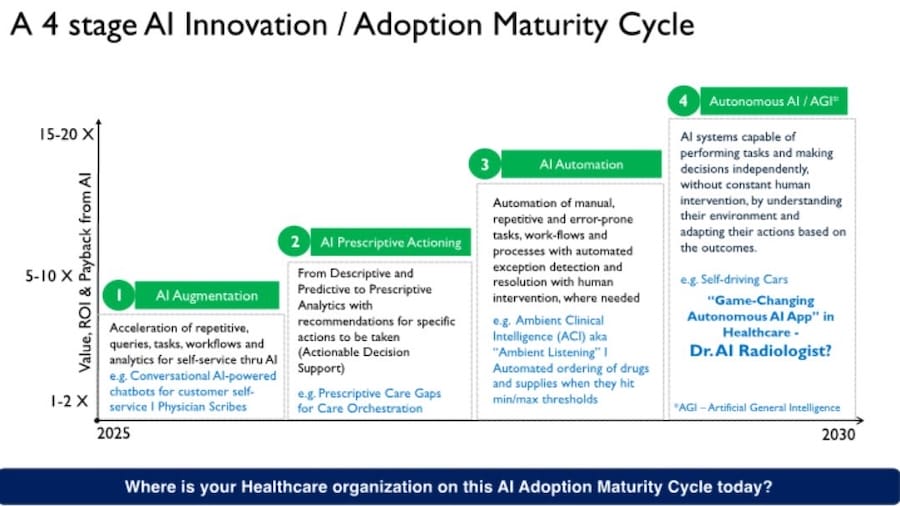A recent report from MIT, The Gen AI Divide: State of AI in Business 2025, reveals a striking gap between AI investment and adoption. While 80% of organizations have purchased Gen AI tools like Copilot, ChatGPT, or Claude, fewer than one-half have moved beyond experimentation. Only 40% have deployed these tools, 20% have reached a pilot stage, and a mere 5% have scaled to full production. The challenge is not in buying these tools, but rather in operationalizing them. For most industries, Gen AI remains stuck in pilots.
Given this hard truth, how can healthcare organizations move from hype to real, structural change? It starts with an AI adoption maturity lifecycle, and it has four stages.
With the extremely rapid pace of change and developments, CXOs are struggling to craft a coherent and value-driven AI strategy execution plan and roadmap.
To sharpen and inform their AI strategies, here is a simple yet intuitive AI innovation and adoption maturity lifecycle (see figure 1).
The x-axis depicts the temporal evolution of AI over the next 5 years (estimated) while the y-axis articulates the anticipated value, ROI and payback from AI investments for healthcare and life sciences organizations.
Figure 1 (source: Lightbeam Health Solutions)
Stage 1 – AI Augmentation
AI Augmentation involves acceleration of repetitive queries, tasks, workflows, and predictive analytics for self-service. It leverages AI modalities like Machine Learning (ML), NLP, NLG, and Gen AI/LLMs. Think about early physician scribes, conversational AI-powered chatbots as well as Gen AI platforms like GPT 5, Claude, Gemini, etc., for faster response to queries.
The value and ROI enabled has been incremental in terms of enhanced productivity, some savings in FTEs, and higher customer satisfaction from self-service empowerment.
Stage 2 – AI Prescriptive Actioning for Decision Support
AI Prescriptive Actioning enables a significant step forward from descriptive analytics (yesterday’s weather report) and predictive analytics (the weather forecast) to prescriptive analytics (the alert to carry an umbrella). In healthcare, prescriptive actioning gives recommendations for decision support at the point-of-care. Think about surfacing open care gaps in real time while the patient is in front of you, so clinicians can close them on the spot.
The ROI potential of prescriptive actioning is considerably higher than just predictive analytics. It provides specific, intelligent, and actionable recommendations to enhance patient outcomes, maximize revenue uplift, cost savings, customer satisfaction, employee productivity, and other critical business objectives and metrics.
Stage 3 – AI Automation with or without Human Intervention
AI automation with or without human intervention represents a seismic shift that will enable organizations to realize the promise and potential of Agentic AI and AI Agents. By streamlining repetitive, error-prone tasks, workflows and processes, organizations can unlock measurable value. Perhaps the best recent example of AI Automation in a clinical context is Ambient Clinical Intelligence (ACI), better known as “Ambient Listening,” where the entire patient encounter with a physician or nurse is recorded on an ambient listening app. The encounter is converted automatically from speech to text and presented to the clinician or nurse for a quick review or edit. Once approved, it’s uploaded as the physician’s notes from the encounter into the EHR, helping clinicians focus more on the best treatment experience and outcome for the patient.
This iswhere healthcare will realize the greatest value, ROI, and payback from AI. It will boost physician, nurse or care manager productivity, expand capacity for virtual patient engagement without adding staff, and eventually automate entire sets of processes performed by humans. In fact, this is already happening in Japan and Thailand where multi-lingual robot nurses deliver medicines and meals, record vital signs, and schedule patient appointments. This allows staff to focus on other tasks that only a human can do.
Stage 4 – Autonomous AI without Human Intervention
Autonomous AI refers to AI systems capable of performing tasks and making decisions independently without constant human intervention. It understands their environments and adapts their actions based on the outcomes. Perhaps the best example of autonomous AI is self-driving / driverless cars that leverage machine vision and AI intelligence.
While it is indeed daunting to imagine autonomous AI in a healthcare context, it’s no longer science fiction either. Think about the notion of a “Dr. AI Radiologist” that can automatically scan thousands of DICOM images (X-Rays, MRIs and CAT Scans, etc.) within minutes. This AI not only can document findings but also flag cases with acute risks, such as a heart attack (myocardial infarction) or stroke. From there, the resident radiologist can confirm before routing to the neurosurgeon or interventional cardiologist. Remarkably, this scenario is already reality today.
Leveraging the four stages to inform AI strategy and execution
A fundamental fallacy is FOMO-driven CXOs focused on the following questions:
- What should I do from an AI perspective?
- What AI tech/modality should we use?
- What can we do with Gen AI/ LLMs in our organization?
These are the wrong questions to inform an AI strategy.
Instead, start with: Where can I deliver disproportionate value and ROI to my organization through AI augmentation / actioning and automation?
Then use the following “Why, Who, What, How, So What?” Innovation Strategy Matrix to answer the question.
- Why: Define the business rationale for your AI innovation strategy
- Who: Identify the personas impacted (clinicians, nurses, patients, care managers, etc.)
- What: Pinpoint the use cases and jobs-to-be-done that deliver the highest “bang-for-the-buck” to justify your AI investment. Be specific. Do not “boil the ocean.”
- How: Determine the AI modalities needed to augment or automate the use cases and jobs-to-be-done as well as any build/buy/partner considerations.
- So What? Establish the specific metrics, KPIs and ROI that will define success or failure.
Healthcare is entering a defining moment.
Adopting this four-stage AI innovation/adoption maturity lifecycle enables healthcare organizations not just to align strategy and governance, but also to unlock the transformative power of AI. Don’t be left behind in the hype. Those who embrace it will lead the industry into a new era of efficiency, equity, and better outcomes for everyone.

Andy Dé
Andy Dé is the Chief Marketing Officer (CMO) of Lightbeam Health Solutions.








